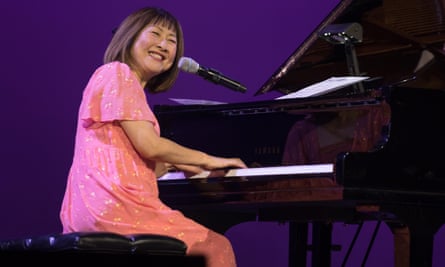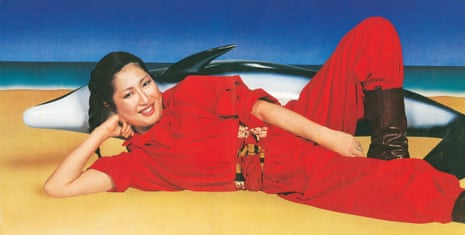Akiko Yano is laughing as she tells the story of her debut album, Japanese Girl. Twenty-one years old and unable to speak a word of English, she found herself directing a recording session in LA with US rock outfit Little Feat. “I still don’t know how it was possible,” she says, over a video call from her home in New York City. “You play this, you play that!” So clear was her vision, Little Feat tried to return their fee because they thought they hadn’t earned it. She smiles. “I feel sorry about that now.”
This singularity of purpose has been a constant in Yano’s 50-year career. A pianist with an unmistakable voice, a love of synthesisers and an ear for pop melodies, Yano is one of the most celebrated Japanese musicians of her generation. Central to the techno-pop sound that made global stars of Yellow Magic Orchestra (YMO) in the late 1970s, she blazed a trail that has yet to be fully recognised outside Japan, though hopefully a current reissue campaign will help, along with the vocal approval of a generation of young leftfield artists such as Clairo and Jessy Lanza. “These are such big, beautiful songs,” enthuses another fan, indie-popper Mac DeMarco, over the phone to me. “There is this fearlessness in the music that really puts gas in my tank.”
Born in Tokyo in 1955, Yano spent much of her childhood in the northern coastal town of Aomori. She started playing piano aged three at the behest of her mother, whose own ambitions as a pianist had been thwarted by the outbreak of the second world war. Aged 11, Yano developed a passion for jazz, and with little live music on offer, convinced her father to take her to the local jazz kissa – the small listening bars where suited men smoked cigarettes over strong black coffees. In a scene that feels lifted straight out of a Haruki Murakami novel, Yano was deposited at the counter, where she drank a Coca-Cola and spent hours lost in the music.
Yano describes her transition from high-school student to gigging jazz pianist to pop maverick with a seamlessness that underplays quite how impressive a musician she was. “It was like a dream come true” when, at 17, she joined Tin Pan Alley, a pop group headed by Haruomi Hosono, later of YMO. “I felt like I had been playing with them for years.”
She called herself the “new kid” on the scene, and her Japanese Girl bucked the trend towards US- and UK-influenced chart music by folding traditional Japanese melodies into a wild mix of jazz improvisation and electronic pop. “I thought it should stand out from the others,” she says. “Nobody had made that sound before.”
Yet, despite her predilection for pushing boundaries, Yano remains remarkably unassuming about her early work. Was it radical to be self-producing her albums? No, not really, she just thought it would be easier that way. Was it unusual to use an ARP synthesiser in 1976 (a year before it appeared on David Bowie’s Low)? She shrugs and says she never really thought about it.
“That’s the thing,” she explains, “I didn’t have that bigger picture.” Instead, Yano took life as it came, and in the late 1970s it was coming pretty fast. She was both dating and working with YMO member Ryuichi Sakamoto, so “the YMO-Akiko Yano back-and-forth was really natural for us”. YMO played on her records and Yano played with them on tour; influence flowed both ways. “I can still say it was an ideal environment working with Ryuichi, because we respect each other. The personal thing comes after. To me, the artistic connection is much more important.”

Despite Yano having “no interest in being a star”, the use of her track Harusaki Kobeni on a cosmetics commercial in 1981 did give her a hit. When the record company implored her to make an album along similar lines, she turned in her most experimental record yet. Tadaima was a riot of punk electronics that featured, among other things, a nine-minute suite of short stories written by children. “I don’t remember exactly what the record company said, but eventually they agreed to release it. It was kind of my statement.”
This sense of mischief plays across all her album covers, which are as iconic as they are subversive. The fibreglass dolphin and Issey Miyake jumpsuit (“he was really a fan of my music”) of Iroha Ni Konpeitou; Yano’s beaming smile, front and centre on Gohan Ga Dekitayo; the kimono-clad portraits with cows and elephants for Ai Ga Nakucha Ne.
Recorded in London with David Sylvian’s Japan in 1982, Ai Ga Nakucha Ne (reissued this month) broadened her horizons. She bumped into Elvis Costello in the studio and shared an apartment block with Duran Duran, an encounter she remembers fondly, despite the mess they left in the elevator. There is a lightness to the stories she tells from this time, which often end in wild laughter.
Yet a truly international pop career never materialised. Having had a child with first husband Makoto Yano, she was used to working as both a musician and a mother. “That was the basis of my life. [The two things] did not compete.” By the early 1980s Yano had a second child, with then husband Ryuichi Sakamoto, and the freedoms afforded to her male counterparts were simply no longer available to her. “I always wanted to expand my audience outside Japan, but I was so busy I had no time to think seriously about it.” As a result, she had to turn down opportunities that would have changed her trajectory once more. One such offer, she reveals, was to work with Annie Lennox.

But Yano has no regrets. In 1990, she and Sakamoto – who later divorced – moved to NYC so she could embed herself more fully in the jazz scene and return to her first love, playing the piano. “Jazz is my passion and improvisation is my life,” she says, serious for a moment. “It’s a real honour to play with greats like Charlie Haden and Pat Metheny. It’s still unbelievable to me.”
After 27 albums, Yano’s audience is finally expanding outside Japan. “I don’t know where it comes from, this artistic mind, but it’s in my blood. I think it will never die.” DeMarco tells me he would love to collaborate with that mind one day: “She outshines me in every possible way musically, but maybe we could make something cool. The honour would be all mine.” For her part, Yano relishes the energy of youth, listens (occasionally) to Justin Bieber and confirms that yes, she is up for making that album with DeMarco.
“I feel so grateful, because not many musicians my age can have this privilege,” she says. “At the same time, it’s proof that I have been making music which never fades. And that gives me real contentment.”
The reissue of Ai Ga Nakucha Ne is out now on Wewantsounds, adding to reissues of Gohan Ga Dekitayo, Iroha Ni Konpeitou, Japanese Girl and Tadaima.

Comments (…)
Sign in or create your Guardian account to join the discussion